Terms and Definitions for ENSC 201 Test #3 (Lectures 13-20 inclusive)
1/194
Earn XP
Description and Tags
Name | Mastery | Learn | Test | Matching | Spaced |
|---|
No study sessions yet.
195 Terms
What are species differences in environmental toxicology?
Different species are more or less sensitive to the toxicity of a given toxicant
Individuals from the same species show differences in susceptibility to toxicity
Examples: TCDD effects on different fish species, thalidomide sensitivity based on human genetic makeup (species vary in ability to detoxify ROS species via antioxidants)
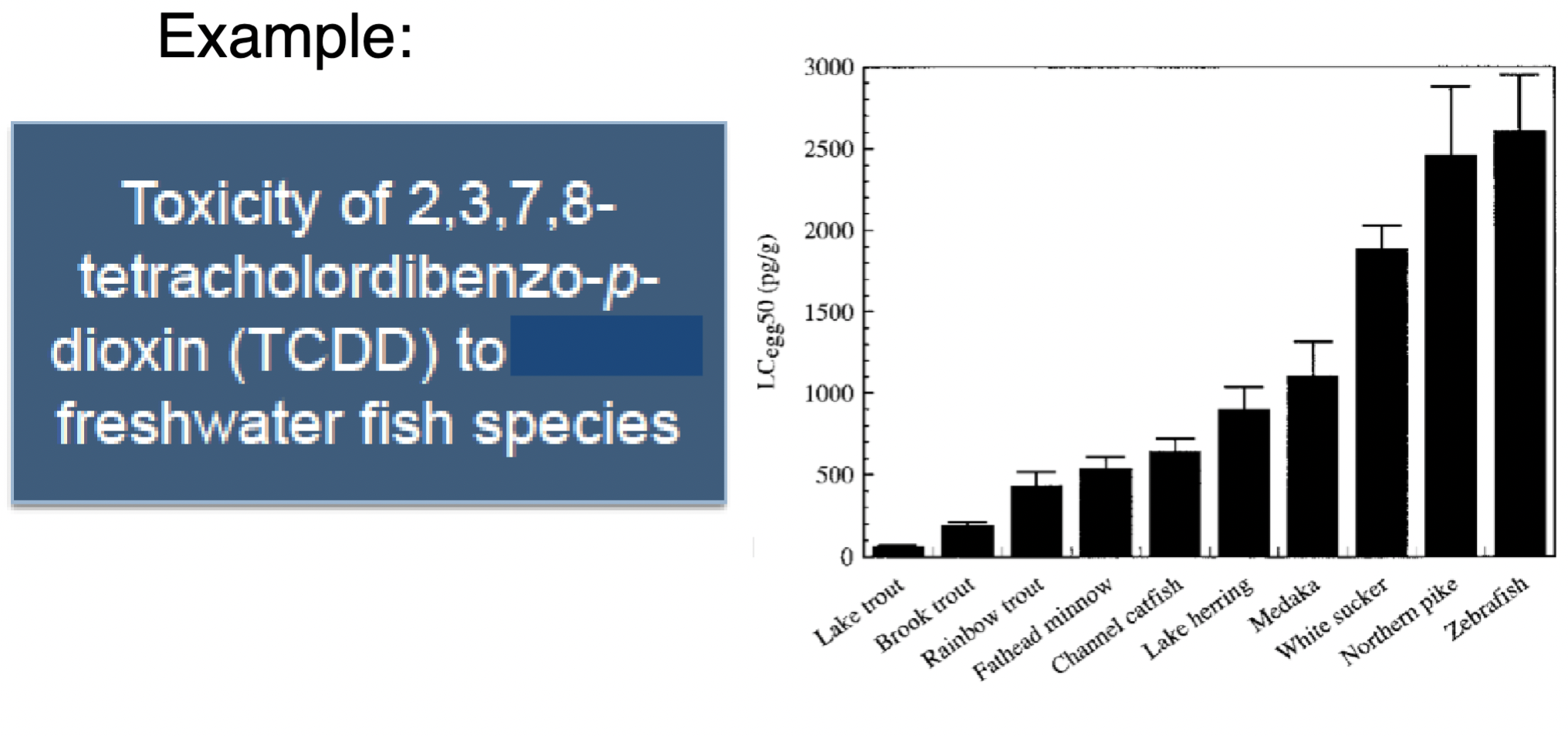
Benefit of being more tolerant to toxicants
More tolerant individuals survive longer and are more likely to reproduce
Susceptible populations (aka vulnerable populations)
Populations that may be defined as having unique characteristics, or living in environments, that make them more susceptible to environmental risks
2 toxic effects of thalidomide
Compound caused cell death (due to reactive oxygen species production)
Reduced amount of certain differentiated cells (reduced growth and replication of affected tissues, missing or deformed limbs)
6 examples of vulnerable populations
Children and pregnant women
Elderly/seniors
Indigenous people
Non-healthy, immunocompromised
Lower socioeconomic status
Individuals in areas of war
7 biological factors that make infants/children a vulnerable population
Biological differences in pharmacokinetics (ex. basal metabolic rates)
Higher respiration
Higher skin absorption
Proportionally larger body surface area to their weight
Need more food, water, air per unit of body weight
Blood brain barrier is more permeable in infants
Wide difference in metabolism of toxicants
5 behaviours that make infants/children a vulnerable population
Children live, learn and play in different physical environmental than adults
Oral uptake much higher in children (hand-to mouth activities)
Eating with contaminated hands, uptake of soil
Hands and knees of crawling children prone to dermal absorption of chemicals, inhalation of dust
Close contact with pets (Insecticide exposure from pets) treated for parasites
Infant botulism
Occurs when infants consume contaminated honey due to an immature digestive system
Spores are ingested and colonize in large intestines of babies
Spores are usually harmless to adults and children over 1 year old, because microorganism in mature intestines keep the bacteria from growing
5 knowledge gaps when studying vulnerability of children/infants to toxicants
Changes to metabolism during pregnancy
Exposures are variable and often estimated retrospectively
Existing human studies are very limited in scope
Children are not mini-adults (ex. covid vaccine efficacy)
Due to gaps in knowledge, regulations often include additional safety factors
Outcome of National Children’s Study
NIH deemed study was not feasible in 2014 > $1.2 billion spent
Due to too many variables and to difficult to conduct

National Children’s Study
A study initiated in 2000 to examine the effects of environmental influences on the health and development of more than 100,000 children across the United States
Idea was to follow child from before birth until age 21
Goal was to improve the health and well-being of children
Biomarkers: blood, breast milk, hair, DNA from fingernails
Environmental samples, housing, social, interviews
Why is environmental justice important?
Low-income communities and minority ethnic groups often bear a greater burden of the consequences of environmental contamination
7 factors that make elderly people a vulnerable population
Process of aging (ex. the kidneys and liver, some of the fastest aging organs, can be compromised and affect clearance of substances)
Altered metabolism (repair)
Weakened immune system
Drug to environmental chemical interactions
Physical or mental impairments may make it difficult for the elderly to care for themselves (ex. decreased mobility, increased chronic illness, changing nutritional needs, vision loss)
Financial concerns
More susceptible to certain contaminants (i.e smog)
7 examples of environmental injustice
Access to safe drinking water
Access to proper nutrition
Low-income families more likely to live in older homes with lead pipes and lead paint
Proximity to industry or waste sites
Migrant farm workers exposure to pesticides
Mental health (i.e covid)
Homeless populations and air pollution
Grassy Narrows Case Study
Near Grassy Narrows, ON a paper mill in Dryden released mercury (1962-1970) in the Wabigoon River and residents developed Minamata disease from eating contaminated fish
More than 90% of residents in Grassy Narrows and Whitedog First Nations have symptoms of mercury poisoning
8 challenges for regulation specific to susceptible/vulnerable populations
May warrant separate risk assessment
Lack of data or limitation of data
Need behavior/lifestyle information
Extrapolation of dose to human exposure
How do we define baseline
What about delayed effects?
Lack of resources
Uncertainty as to how the data will be used
One World, One Health (environmental justice approach)
Intersections of human, animal, and environmental health
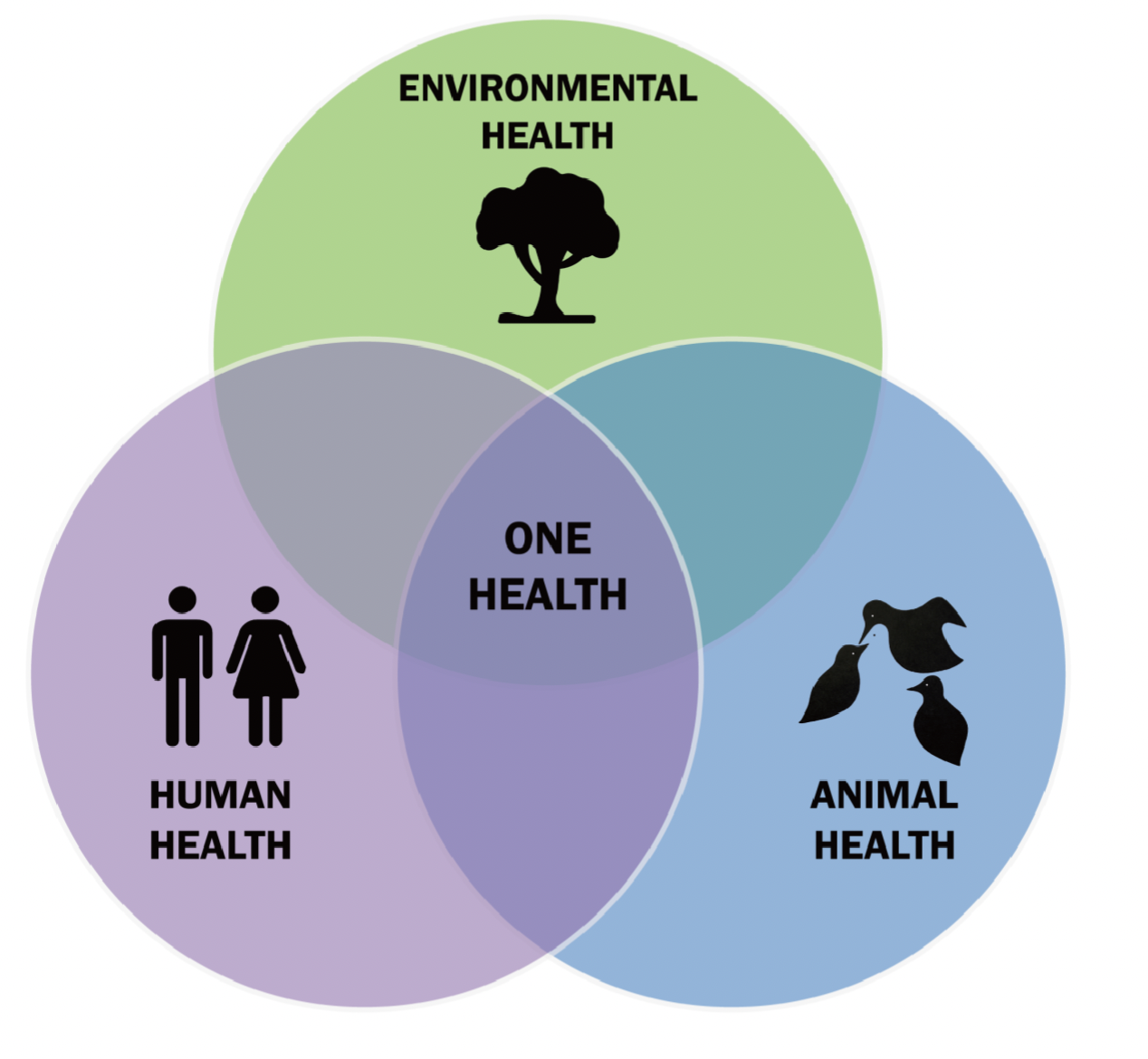
Ultimate goal of pulp and paper industry cleanup
To reduce all forms of waste by efficiently converting resources to products (the ultimate goal: zero effluent!)
3 key points of pulp and paper lecture
Economic benefits vs environmental damage
Complex effluents create complex effects
End-of-pipe solutions are more expensive than process control
3 products of pulp and paper industry
Market pulp
Boxboard, Cardboard
Paper: sanitary, tissue, clay-coated, printing, writing, packaging, industrial, newsprint
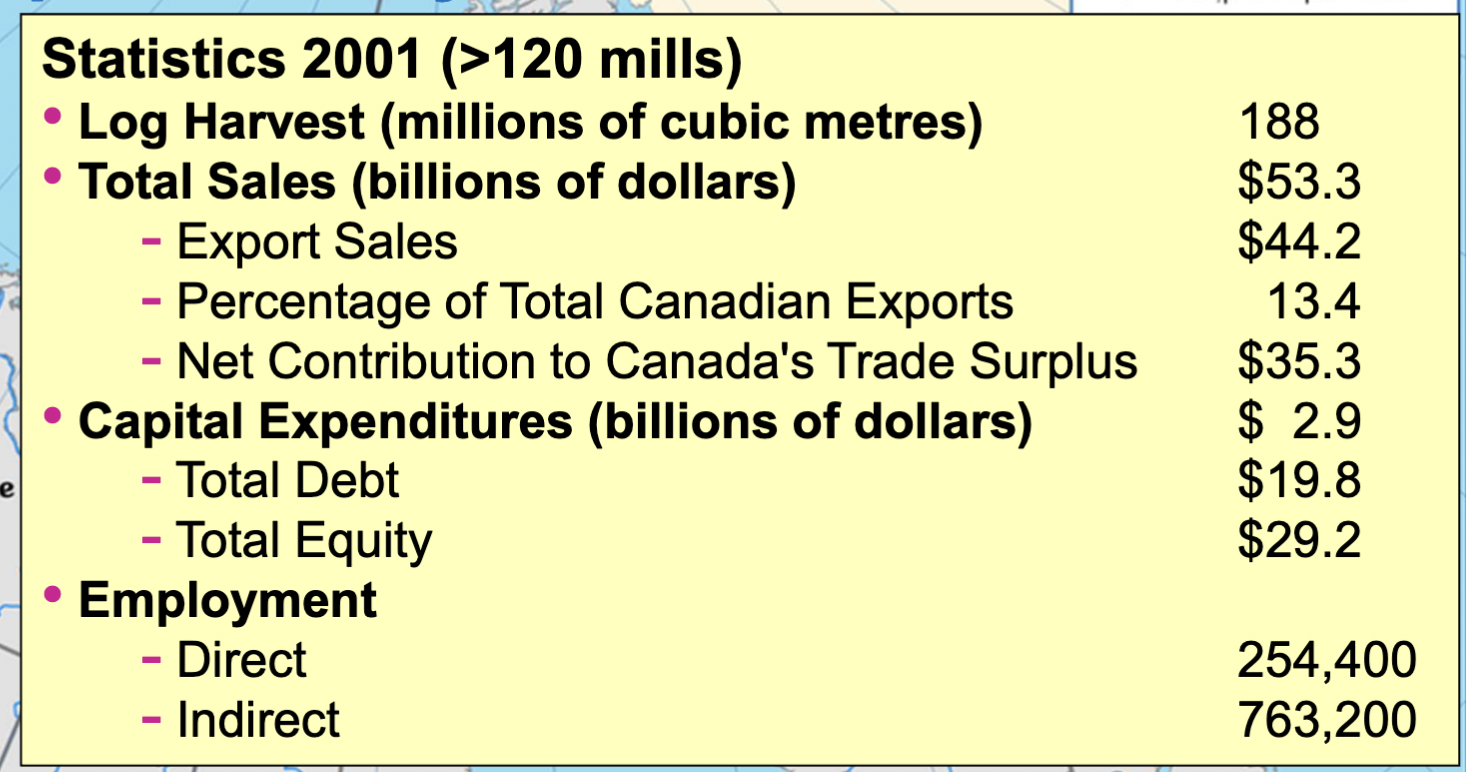
5 recent trends in the pulp and paper industry
Continued growth globally (esp. Asia, driven by packaging from on-line shopping)
Decline in printing papers and Newsprint (on-line news)
Most new mills in Asia and Latin America (bigger and more efficient than older mills in North America and Europe)
Accelerating industry consolidation – larger conglomerates; closures of smaller mills
Recent (2022-23) mill closures in Canada—> impacts are felt in mill towns and in communities that supply timber
4 big-picture environmental impacts of the pulp and paper industry
Habitat destruction (deforestation, changes to lakes and rivers, dams, physical damage to benthic habitats via log floating)
Water consumption for processing
Soil pollution from disposal of solid wastes (e.g wood products like bark, biosolids)
Air pollution (high CO2 emissions, reduced CO2 fixation, toxic emissions (sulfur compounds, methanol, etc))
Water pollution (oxygen consuming substances, toxic chemicals, persistent bioaccumulative compounds)
3 Physical impacts of pulp mills— Hydroelectric dams
Change flow and temperature regimes
Block fish migrations
Upstream sediment accumulation
3 Physical impacts of pulp mills— Log driving
Scour river bottoms
Create fibre deposits
Release toxic wood extractives
3 Chemical impacts of pulp mills— components of wood
Products: fibres (cellulose and hemicellulose)
Numerous potential byproducts: sugars (= energy); lignin (= glue); extractives (tall oil (fatty acids), turpentine (alcohols, phenolics), resin acids, phytosterols)
Lignin
A random polymer of phenolic compounds
Lignin degradation by pulping and bleaching creates a wide array of toxic phenolics and polyphenolics
Table of pulping processes
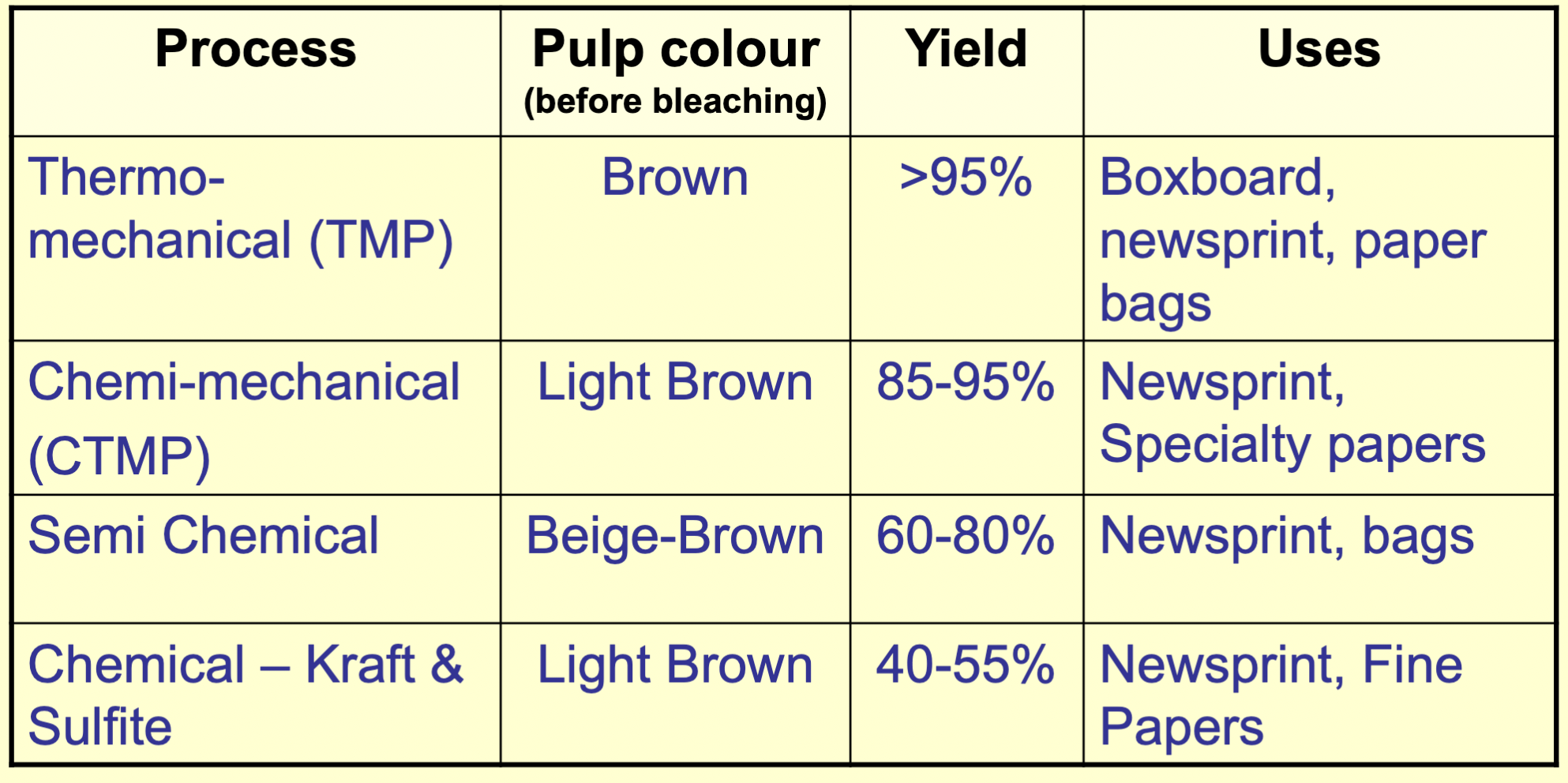
Chemical impacts of pulp mills— stats
Total pulp production (million ADMT*/yr) = 22.9
Average water consumption (m3/ADMT) = 100
Total estimated water use (million m3/yr) = 2,300!
Estimated loss of organic material (T/y) = 230,000
3 categories of effluent chemicals affecting aquatic environments
Oxygen consuming wastes
Chemical spills
Persistent, bioaccumulative and toxic (PBT) compounds
3 types of oxygen consuming wastes
BOD ( Biological Oxygen Demand)
COD (Chemical Oxygen Demand)
Wood fibre
2 types of chemical spills
Alkaline pulping solutions
Acid bleachery wastes
5 types of persistent, bioaccumulative and toxic (PBT) compounds
Mercury (Hg)
Resin and Fatty acids (and chlorinated derivatives)
Chlorinated phenols
Chlorinated dioxins and furans (e.g., TCDD or 2,3,7,8 tetrachlorodibenzo-p-dioxin)
5 water quality zones when affected by oxygen consuming wastes
Clean Zone —> Decomposition Zone —> Septic Zone —> Recovery Zone —> Clean Zone
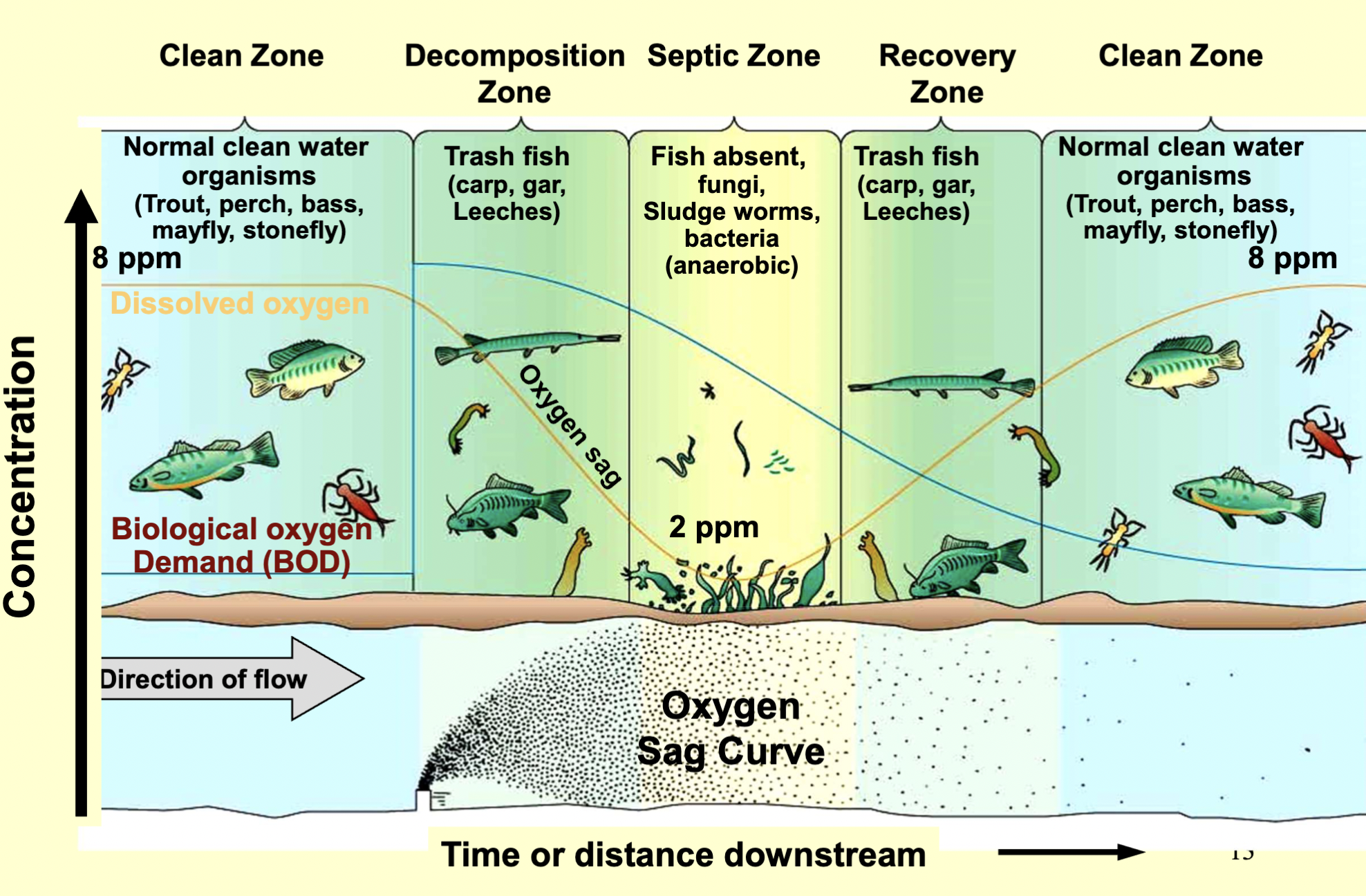
3 steps for pulp mills to become a source of mercury (Hg) contamination
Electric current causes the evolution of chlorine gas used in bleaching and NaOH (alkali) used in pulping
Electric currents transfer elemental (Hgo) to the chlorine gas and Hg ions (Hg2+) dissolve in the brine —> the Hgo and Hg2+ contaminate liquid and solid wastes and receiving environments
Hg methylation by sediment microbes causes food web contamination
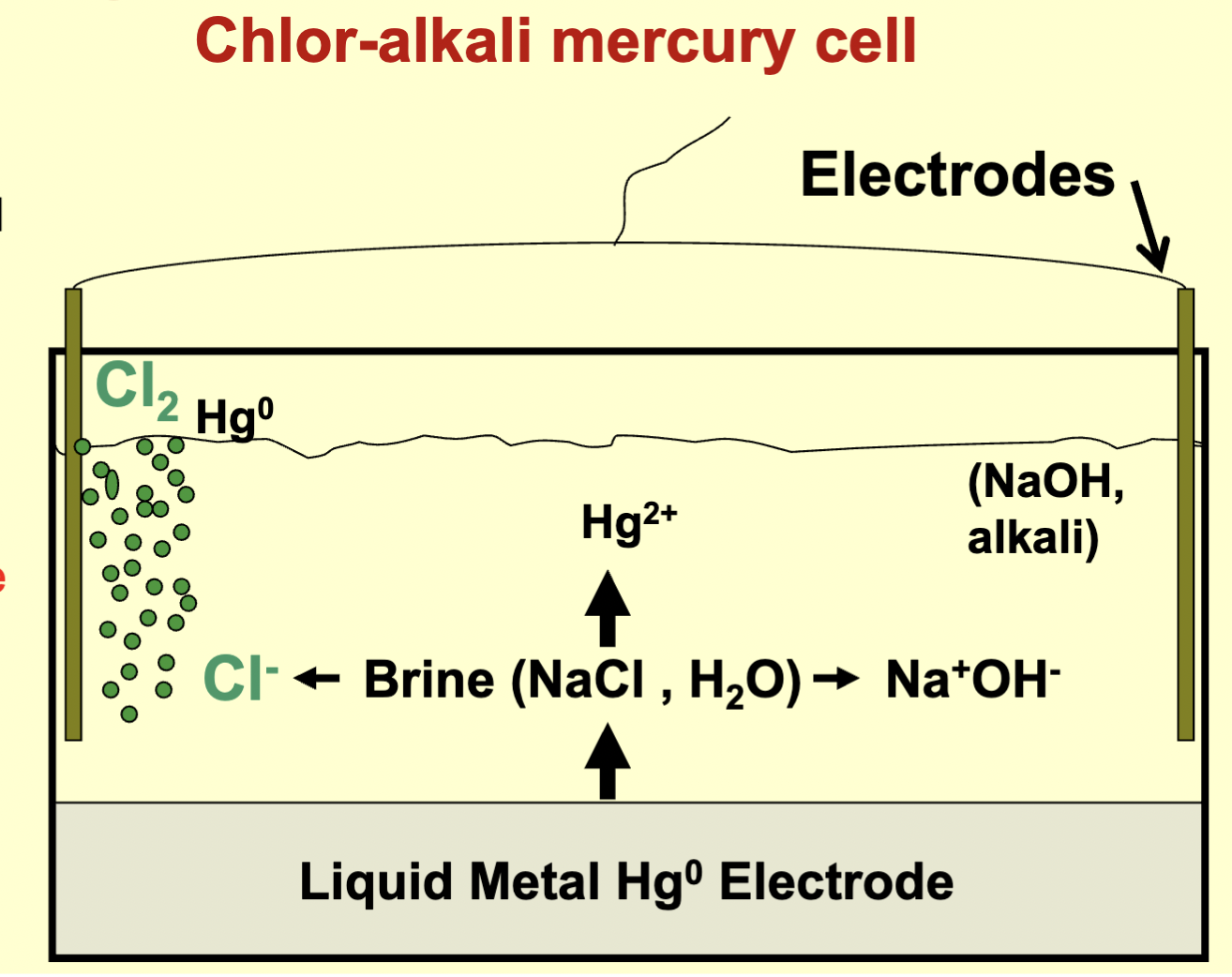
2 major mercury sources in the pulp and paper industry
Phenyl-mercuric acetate
Used as a paper mill slimicide (hydrophobic, bioaccumulative)
Chlor-alkali mercury
Mercury combined with chlorine gas used for bleaching paper
4 pulp bleaching agents
Chlorine, hypochlorous acid (Cl2,
HClO)
Alternatives most commonly used since 1995
Chlorine dioxide, hypochlorous acid (ClO2,
HClO)
Peroxide (H2O2)
Ozone (O3)
Chlorine, hypochlorous acid (Cl2, HClO) as a bleaching agent
Very efficient, not much fibre breakage
Generates chlorinated compounds
Abandoned in the early 1990’s (crisis of chlorinated dioxins in fish & shellfish)
Chlorine dioxide, hypochlorous acid (ClO2, HClO) as a bleaching agent
Main bleaching agent in Canada
Most efficient
Minimal chlorinated contaminants
Worker safety issues
Peroxide (H2O2) as a bleaching agent
No chlorinated contaminants
Less efficient
Used alone or in combination with ClO2
Ozone (O3) as a bleaching agent
No chlorinated contaminants
Less efficient
Used alone or in combination with ClO2
Effect of untreated pulp and paper industry effluents on fish
Wood extractives ‘mimic’ cholesterol, block cholesterol uptake, and impair sexual maturation
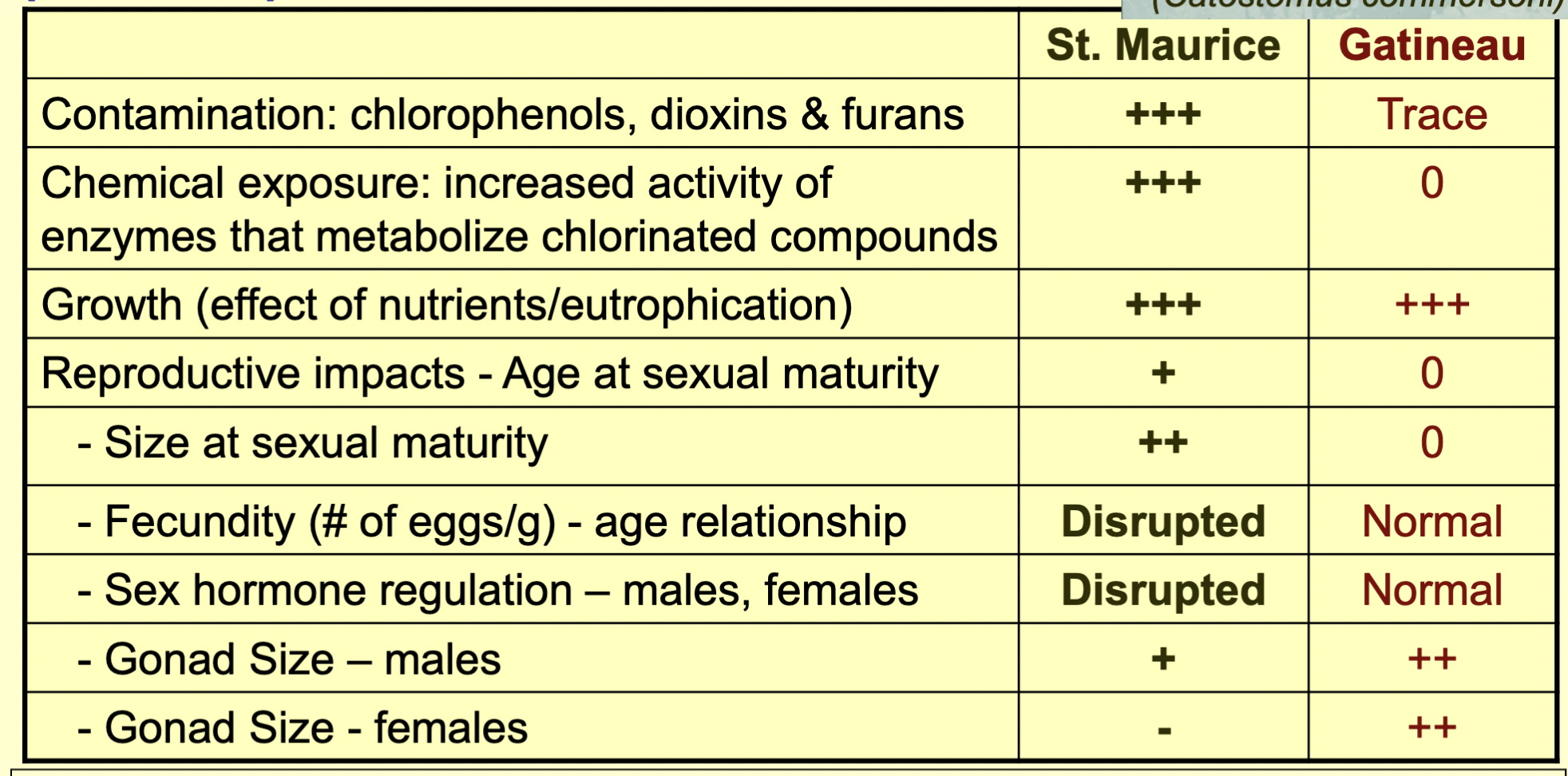
2 End-of-pipe solutions for effluent
Effluent Treatment
Aeration-Stabilization Ponds (Less sophisticated than activated sludge, less costly to operate, but require much more land)
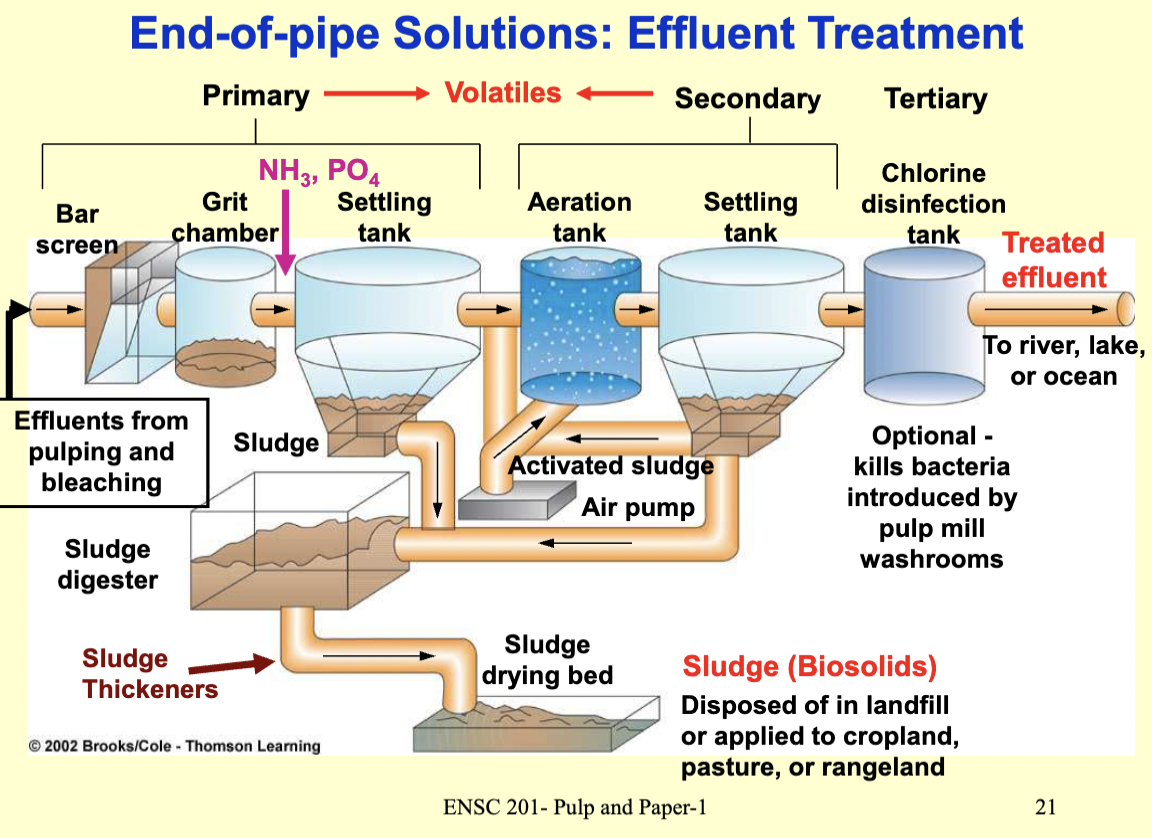
2 benefits of treating pulp-mill effluent
Reduces oxygen demand
Reduces acute toxicity
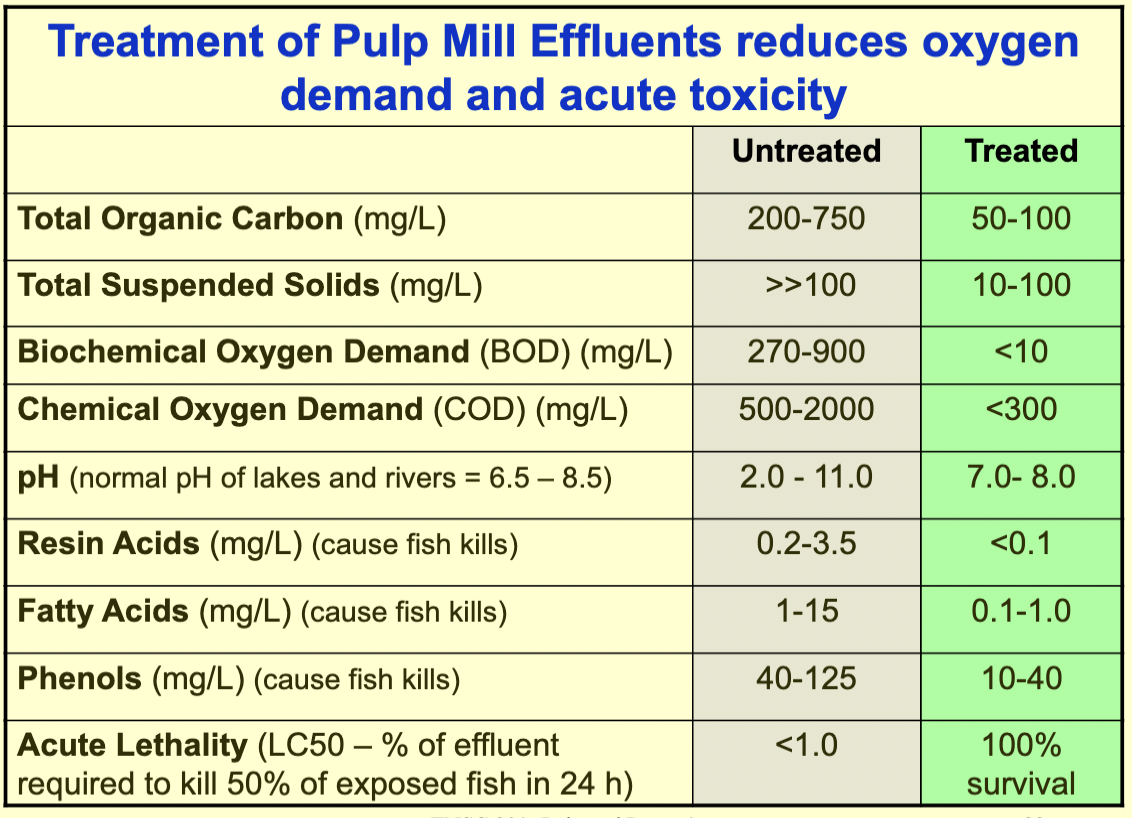
4 changes to pulp mill impacts (post 1980’s)
Physical – smaller ‘footprint” with a greater reliance on recycled fibre
Lower discharge of BOD, COD, toxic chemicals
Virtual elimination of dioxins and furans
Fish kills rare with less sublethal toxicity
Effluent treatment (1° universal; 2° almost universal; 3° rare)
New issue with pulp mill impacts
Eutrophication due to nutrient enrichment from waste treatment
The Great Pulp Mill Effluent Onion (conundrum + question)
Conundrum:
As each contaminant problem is solved by more effluent treatment, an unknown or unexpected problem is revealed
The ultimate question:
If the effluent is not clean enough to re-use in the mill, why is it clean enough to discharge to the
environment?
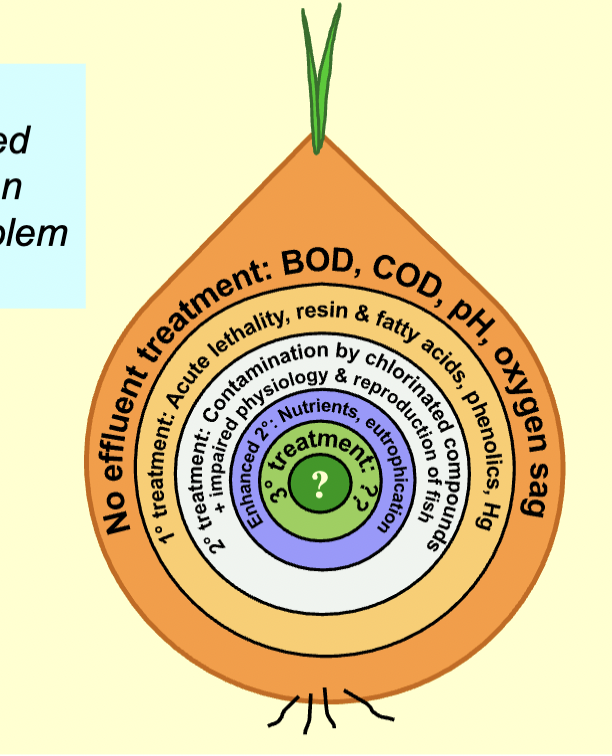
Is more effluent treatment the answer?
NO!
Instead of end-of-pipe solutions, improve the pulping and bleaching processes
5 ways to improve the pulping and bleaching processes
Recover carbon from pulping liquors and waste fibre and recycle as green energy
Replace Cl2 for bleaching with oxygen delignification
Re-use and recycle wash waters
Reduce mill ‘upsets’ with computer process control
Identify toxic waste streams and focus controls on specific sources before they are diluted and difficult to treat
Ultimate goal of improving the pulping and bleaching processes
A zero discharge, closed loop mill (re-use water)
Challenges of improving the pulping and bleaching processes
Remove chemicals from effluents without:
Increasing toxicity
Creating solid waste
Releasing air pollutants
Toxin
Naturally occurring molecules that are injurious to some living organisms
Toxicant
Any toxic substance, whether anthropogenic or naturally occurring
3 toxic plants
Poison hemlock
Monkshood
Black henbane
Toxic effects of poison hemlock
Produces alkaloids that affect neuromuscular functions
Causes respiratory failure
Other members of the Apiaceae (carrot) family (Queen Anne’s lace, Cow parsley, carrot) are less toxic or nontoxic
Giant Hogweed produces photosensitizing furanocoumarins— react with the skin in light
Toxic effects of monkshood
Produces alkaloids (e.g., Aconitine)— when consumed interact with sodium-ion channels, affecting respiratory and heart functions
Used as wolf poison
Toxic effects of black henbane
Hyoscyamine, Atropine and other alkaloids affect parasympathetic activity by competing with acetylcholine
Coma, respiratory paralysis, and death
These alkaloids are also psychogenic
Now grown or synthesized for pharmaceutical purposes– e.g., analgesic, ophthalmic uses, and to treat brachycardia
3 toxic lower plants
Cyanobacteria (blue-green algae) (e.g., Anabaena, Microcystis)
Dinoflagellates (e.g., Kerenia brevis)
Diatoms (e.g., Pseudo-nitzschia australis)
Toxic effects of cyanobacteria (blue-green algae)
Contain neurotoxins, hepatotoxins, and dermatoxins - cyclic peptides, alkaloids and lipopolysaccharides
Death in domestic animals (cattle) and wild animals from consumption or drinking water
Cyanophyte toxins also contribute to paralytic shellfish poisoning (PSP) (filter feeders ingest the algae and accumulate the toxin)
Toxic effects of dinoflagellates
Produce alkaloids that are neurotoxic - brevetoxin and saxitoxin
HAB–dense blooms called red tides can reach 200,000 cells/ml
Blooms can cause fish kills and contaminate filter-feeding bivalves and whelks resulting in paralytic shellfish poisoning (PSP) in humans
Toxic effects of diatoms
Produces domoic acid (DA,) a neurotoxin
Diatoms are consumed by shellfish (no harmful effects), and toxin can be transferred to seabirds and mammals
DA causes amnesic shellfish poisoning (ASP) in human and other animal consumers
Ecotoxicological effects through the food chain
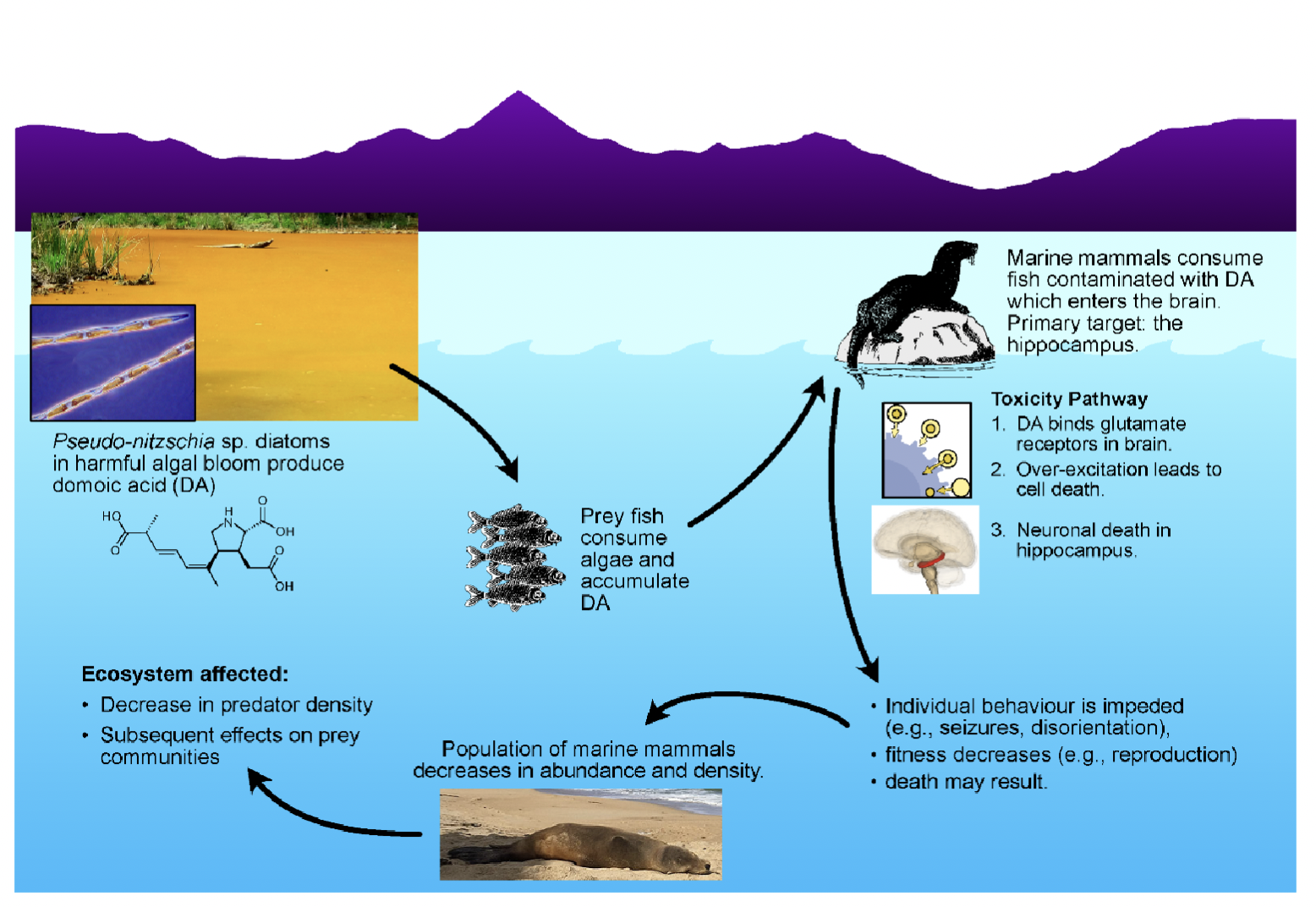
Tetrodotoxin
An alkaloid, a selective sodium blocker causing neuronal, gastrointestinal and cardiovascular symptoms.
In tetrodontid fish (ex. puffer fish or fugu, a delicacy in Japan but also octopus, crab and echinoderms, amphibians and algae)
Organisms seem tolerant of certain levels of toxin and the toxins are passed up the food chain.
Tetrodotoxin is synthesized by symbiotic bacteria/ dietary uptake of bacteria —> widespread similarities among unrelated organisms
3 toxic effects of bacterial toxins
Pathology (e.g., Clostridium difficile, Corynebacterium diphtheriae, Salmonella spp.)
Notorious for toxicity, such as botulism (fatal food poisoning). from Clostridium botulinum
Anthrax (Bacillus anthracis)— tri-partite toxins which cause cardiovascular collapse and death
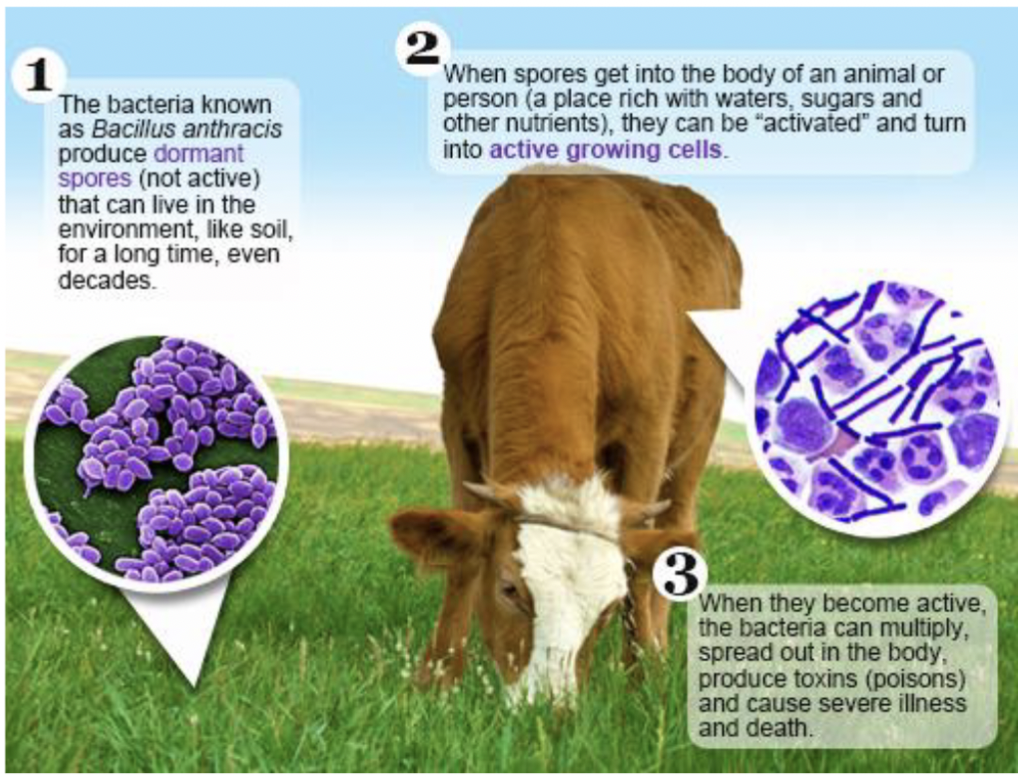
2 types of fungal toxins
Moulds (e.g., Penicillium spp)
Mushroom poisoning (e.g., Amanita phalloides, the angel of death)
Venoms
Cocktails of many toxins (up to 100 different molecules) produced by a wide range of organisms and usually injected by a bite or sting, but also can be ingested;
Ex. proteins, peptides and non-proteinaceous chemicals including neurotransmitters
Contain neurotoxins and cytotoxins, some proteolytic enzymes (aid in digestion of prey)
3 plant toxins with medical applications
Digoxin (from Digitalis)
Opium (from Papaver Somniferum)
Quinine (from Cinchona tree)
Digoxin (from Digitalis)
A glycoside that binds to and inhibits the sodium pump within the plasma membrane of cardiac myocytes;
Used to treat heart failure and arrhythmia
Narrow therapeutic index (the dose makes the poison!)
Opium (from Papaver Somniferum)
Morphine, codeine, heroin, and oxycodone are alkaloid derivatives of opium
Opium is a controlled substance because of its medical benefits (control of chronic pain) but its potential for misuse
Quinine (from Cinchona tree)
Bark contains quinine (an alkaloid)
Controlling/preventing malaria by action on the Plasmodium parasite
Treatment of malaria with quinine: first known controlled use of a natural chemical compound to treat an infectious disease
5 examples of pest control products from natural sources
BT —> Bacillus thuringiensis
Spores germinate in insect gut, lethal to Lepidoptera
Nicotinamides —> Nicotiana spp.
Pyrimidine base insecticide
Pyrethrins —> Chrysanthemum and other Compositae;
Rotenone —> Rhododendron Hortense
Insecticide, and non-selective piscicide
Juglone —> Juglans (walnut tree)
Biocide for fouling of aquatic structures
2 examples of species used for bioterrorism/biological warfare
Ricin —> highly potent toxin produced in the seeds of the castor oil plant, Ricinus communis
Anthrax —> bacterial disease produced in spores of Bacillus anthracis
5 possible ecological advantages of producing toxins
Competitive advantage (e.g., cyanophyte blooms)
Allelopathy (e.g., Juglans produced by walnut trees)
Grazing defence/deterrent (e.g., toxic plants and harmful
algal blooms)
Prey capture and anti-predator deterrent (e.g., venoms, Tetrodotoxin)
Defense against parasites and infectious diseases
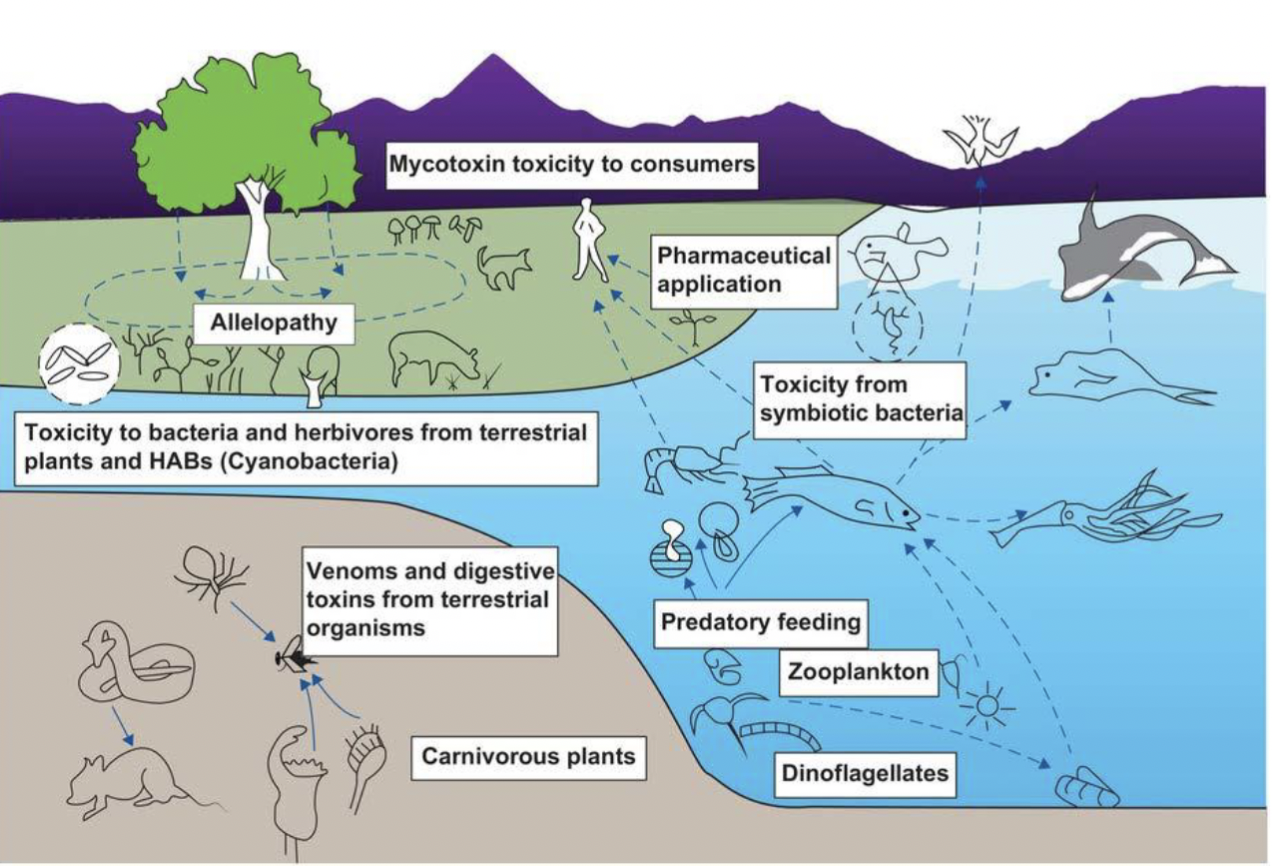
Bioaccumulation
Describes the fate of toxicants in the “biological organism compartment”
Accumulation in food web
Persistence in organism tissues
Depends on chemical properties of toxicant
Two factors that make up bioaccumulation
Bioconcentration
Biomagnification

Bioconcentration
Partition of toxicant into biological organism
Biomagnification (aka trophic enrichment)
The increase in contaminant concentrations from one trophic level to the next through accumulation in food
Assumes almost all contaminant in the prey (consumed) is retained by the predator (consumer) organism
Linked to persistence
4 factors affecting assimilation efficiency of toxicants from food
Speciation— affects solubility and uptake by membrane proteins
Location of inorganics in the prey/substrate (sequestered in exoskeleton makes it not easily digested)
Genetic make-up and digestion by-products (ex. biotransformation and excretion)
Quality of food (digestability differences)
How is biomagnification factor (BMF) calculated
By considering lipid normalized tissue concentrations within an organism vs. lipid normalized concentrations of that in the prey of the organism
Assumes all predator tissues concentrations are obtained from prey
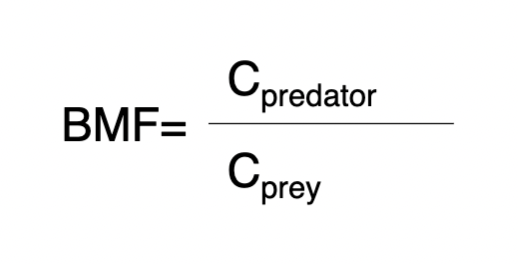
How is biomagnification factor (BMF) interpreted
BMF >1 —> biomagnification occurring
BMF <1 —> no biomagnification occuring
Twin tracer technique (to estimate bioavailability)
Uses two radioisotopes —> one inert and one to be assimilated into the organism’s tissues
Assimilated tracer is quantified once all the inert radiotracer has been eliminated
A single active radiotracer without a paired inert radiotracer can be used, but estimation of assimilated radiotracer is less accurate
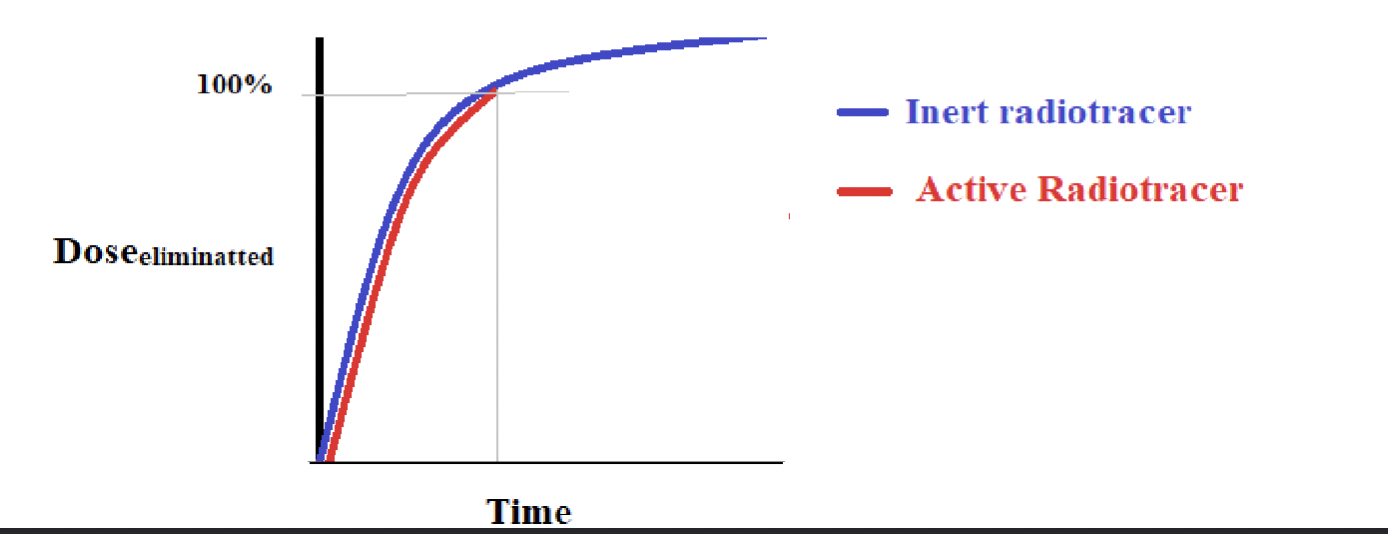
Two assumptions of twin tracer technique
Based on the two assumptions:
The two radiotracers have virtually identical specific activity concept with similar chemical and biological processing behaviour
All active radiotracers are assimilated after the inert radiotracer is eliminated
Trophic levels
The level in which a certain organisms feeds at within an ecosystem
Some use discrete states (i.e: primary producer, primary consumer, etc)
Difficult to class omnivores
Trophic transfer
Transfer of a contaminant across different trophic levels
Three possible outcomes of trophic transfer
Increase in concentration —> Biomagnification/trophic enrichment
No change in concentration
Reduction in concentration —> Biominification/trophic dilution
How to define trophic levels
In labs, trophic levels are imposed (e.g: corn -> rat -> snake -> falcon)
In field studies, organisms may be sorted into trophic levels via literature or visual observations
It is difficult to fit omnivores into discrete levels
How to determine food web
Natural biochemical tracers within organisms can be used to determine prey-predator interactions
When ingested, fatty acids are incorporated into the predator’s cells and can be monitored
Fatty acid compositions vary between taxonomic groups
Fatty acid naming convention
ex. 16:1n-7 , 16:4n-1 , 20:5n-3 …
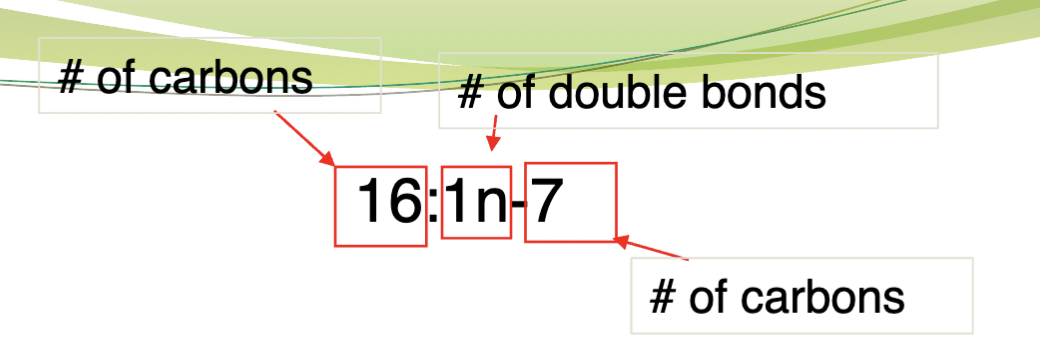
2 methods of determining trophic status
Visual observations
Isotopic discrimination
Isotopic discrimination
This occurs during trophic transfer; where lighter isotopes are eliminated at higher rates than heavier isotopes
i.e 13C is assimilated at higher rates than 12C
Isotopic discrimination of carbon
Carbon isotopes are discriminated by C3 and C4 plants
C3 has higher δ13C than C4 plants
Most reliable isotope for determining trophic status
Nitrogen
Nitrogen as a determinant of trophic status
Normalized to isotope ratio of nitrogen in air
15N quotient increases with increasing trophic status
1.3 to 5.3 % increase/ trophic level, average 3.4% / level
15N quotient is also affected by age of the organisms and diet
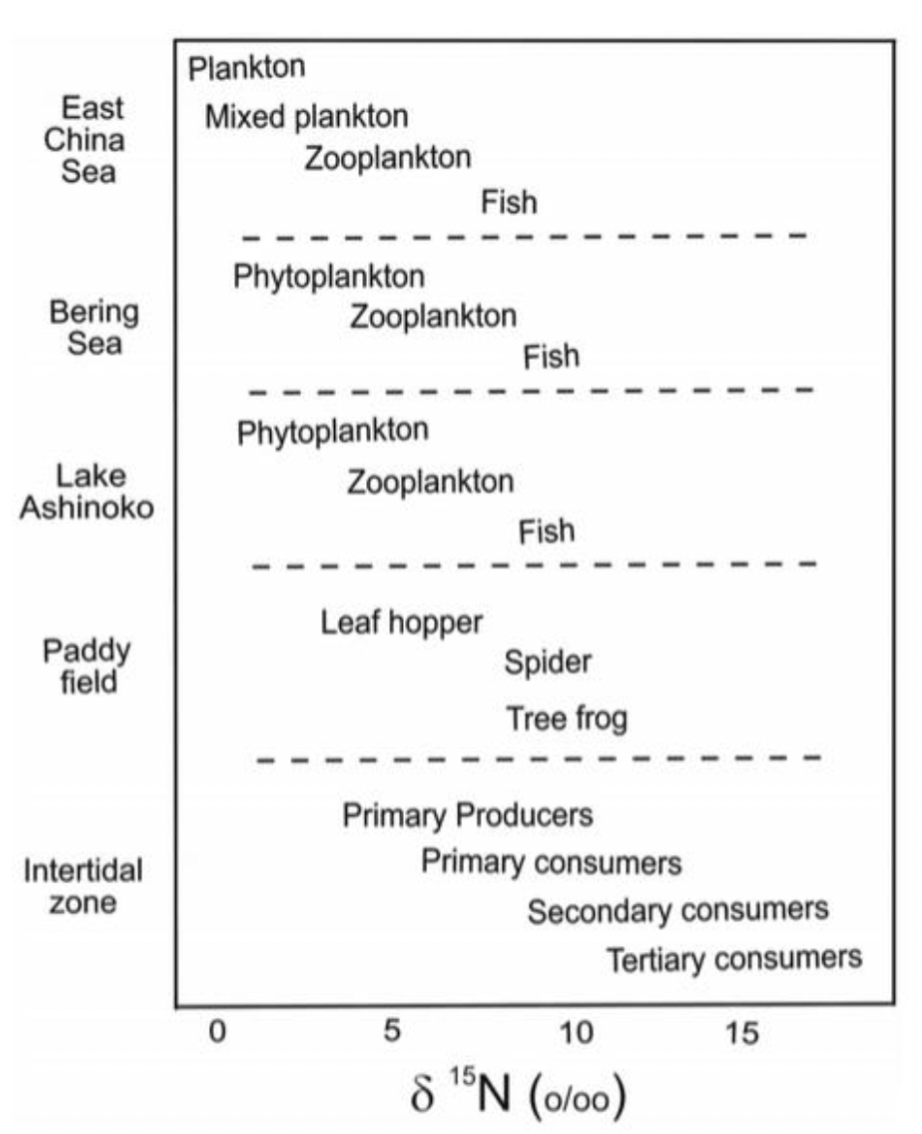
Equation to estimate trophic status of a consumer within the food web
Advantage over using discrete trophic levels
Can position omnivores into intermediate levels

2 other factors affecting trophic transfer of inorganics
Bioreduction (ex. biomineralization of the metals into granules)
Competition between essential elements and their analogs can affect assimilation rates and potential biomagnification (ex. increasing potassium concentration reduces uptake of cesium)
2 major historic oil spills
Exxon Valdez Oil Spill (March 1989)
Deepwater Horizon Oil Spill (July 2010)
Exxon Valdez Oil Spill (March 1989)
Location: Bligh Reef, Prince William Sound, Alaska (US)
Cause: Oil tanker (Exxon Valdez) struck Bligh Reef enroute to California
Result: 11,000,000 US gallons (~ 42,000,000 litres) light crude oil spilled
Outcome: direct mortality, inhibited reproduction, habitat loss, impaired benthic ecosystem nutrient cycling
Affected organisms: Common mures, sea otters, salmon, herring, benthic species (sediment-dwelling— Ex: marine worms, crustaceans)
Deepwater Horizon Oil Spill (July 2010) —> largest marine oil spill to date
Location: Gulf of Mexico (Mexico and US waters)
Cause: Blowout (explosion) of offshore oil drilling rig (66 km from US)
Result: 210 million gallons (795 million litres) of heavy crude oil released over 87 days
Outcome: direct mortality, inhibited reproduction, habitat loss, impaired deep-pelagic ecosystem nutrient cycling
Affected organisms: Phytoplankton, Atlantic tuna, corals, sea turtles, marine mammals (dolphins, manatees, whales)
4 properties of petroleum
Non-polar
Hydrophobic/lipophilic
Low surface tension
Low density (less than water)
3 ways petroleum is indirectly toxic
Water
Soil and sediment
Air
How petroleum affects water
Persistent emulsions that spread easily cause secondary contamination (groundwater transport)
How petroleum affects air
Volatile organic compounds can contribute to greenhouse gas emissions, acid rain